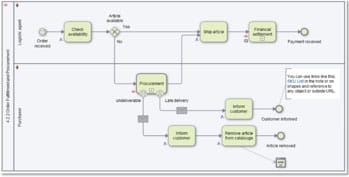
- Business process modelling for return process how to#
- Business process modelling for return process driver#
- Business process modelling for return process software#
Business process modelling for return process how to#
Plan 7x faster Start your free 30-day trial What Is a Return & Refund Policy And How to Use It to Drive SalesĪ return and refund policy is just what it sounds like - a policy that lays out the terms for returning or applying for a refund for one of your products.
Business process modelling for return process software#
Logistics is, of course, a key part of returns management, but managing returns also involves preventative measures, software integrations, and other things not typically considered when using the term reverse logistics. Having a tried and tested reverse logistics process is a great way to optimize how quickly returns are picked up and processed, and minimize the gas and time expenses that are used in picking up a return. Another option is to hire a reverse logistics company to take care of the process for you. Reverse logistics is the process of retrieving returned products, rental products after term, or reusable packaging from customers, and sorting and delivering it to appropriate locations. If the product is in a suitable condition, it will be restocked on the warehouse shelves, added to the inventory count, and can now be sold to a future customer. The product is restocked and put back in inventory Why did the customer return the product? Was it damaged during the delivery and return process? Is this product good enough to restock?Īfter the products are sorted, an auditor will inspect all the returned products and try to answer those questions. The product is sorted, organized, and inspected for quality.
Business process modelling for return process driver#
The product is delivered back at the sorting facility or warehouse and inspectedĪ delivery driver returns the product to a dedicated sorting facility or major warehouse. The company picks up the product from the delivery addressĬompanies that handle returns internally often struggle to optimize the routes of both deliveries and pickups as last-minute orders are difficult to adapt to.Ĭompanies that rely on third-party logistics (3PL) providers will typically use digital prepaid shipping return labels if they cover product returns. Your service staff or dedicated gatekeepers will decide whether or not the customer is eligible according to your company’s returns policy.

Company approves or disapproves the return, exchange, or refund The customer requests a return, refund, or exchange from the company that delivered the product using the proper channels. Maybe the product was damaged, or in the case of apparel, it might just be the wrong size or color. The returns process starts when a customer decides they aren’t happy with the product. Customer receives product, is unhappy, and requests a return or refund The process of returning a product purchased depends on whether it was purchased in-store or online.įor e-commerce businesses and large appliances with home delivery options, these are the stages the product will go through: 1. A returns management process is part customer support, part logistics, and part inventory management. Returns management, or reverse logistics, goes beyond the final delivery and is not used for every customer order. By properly managing returned products you can significantly cut losses by using undamaged returned items to restock warehouse inventory for resale. Returns management is a process in retail and e-commerce that starts with customers wishing to return a product, and ends with the business collecting, organizing, and restocking that product.

3 Examples of a Returns Process as a Competitive Advantage.


Handling outbound logistics is already a challenge, but if one in five products you deliver are sent back, it becomes a massive and costly operational challenge.īut if you do returns management right, you can ensure that you keep the business impact of returns to a minimum. The rates can be even higher for companies that rely 100% on e-commerce sales and offer free returns. Last year, an average of 8.1% of all products that were purchased were returned.


 0 kommentar(er)
0 kommentar(er)
